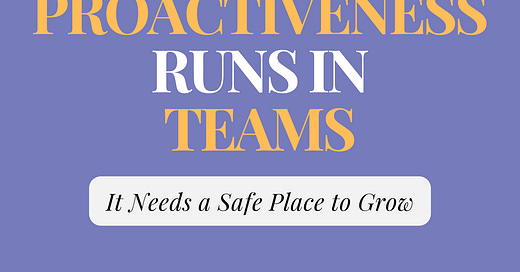Hey there,
How many times have you heard this one: “Ask more questions”? 😅
Maybe you’ve even heard it from me in one of my past articles…
But here’s the catch.
We often tell people to “be proactive,” to “ask questions,” and to take initiative — yet too rarely do we look at the environment they’re stepping into. What happens when a team isn’t ready to receive those proactive questions or actions? Even the most proactive people can only do so much if their team doesn’t support them.
That’s why true proactiveness runs in teams — and it only thrives when everyone plays their part.
Why the team context matters
Imagine someone drafts an early design to spark discussion — a proactive move.
If their teammates jump in with curiosity, add ideas, and appreciate the initiative, that behavior is reinforced and repeated.
But what if their design is ignored? Or met with skepticism?
That one proactive spark may never catch fire again.
Proactiveness requires a team environment where contributions are met with encouragement, not indifference.
What a proactive team looks like
A proactive team is one that:
Listens when someone raises a question — treating questions as valuable contributions, not interruptions.
Responds constructively to early ideas — even incomplete ones — to encourage continuous input.
Fosters psychological safety — so people feel comfortable acting first, knowing they’ll be supported rather than judged.
Recognizes initiative publicly — so everyone sees that proactive behavior is valued.
That’s when proactiveness spreads across the team — as a norm, not an exception.
The chain reaction of team support
When people see that proactive contributions matter — that the team actually responds to them — they do it more. And when more people do it, the team becomes better at catching risks early, improving processes, and sharing knowledge.
Proactiveness is contagious — but only when it’s welcomed.
How to create this kind of team
If you want to build a team that truly embraces proactiveness:
As a leader or experienced team member:
Start with safety — show that proactive attempts won't be punished or judged, even if they don't always hit the mark.
Acknowledge contributions — thank people for bringing up ideas, even if they need refinement.
Make time for early sharing — leave space for drafts, questions, and informal discussions in meetings and chats.
Set the example — model proactive behavior so that it feels safe for others too.
As an individual contributor:
Be the first responder — when a teammate shares an early idea or asks a question, jump in with curiosity rather than criticism. Your response sets the tone for others.
Build on ideas publicly — when someone proposes something, add to it with "Yes, and..." thinking. This shows the team that early contributions lead somewhere valuable.
Ask follow-up questions — show genuine interest in your teammates' proactive attempts. Questions like "What made you think of this?" or "How could we test that?" signal that their initiative matters.
Share your own drafts — be vulnerable first. When you put incomplete work out there and ask for input, you normalize the behavior for others.
Celebrate peer initiatives — don't wait for leadership to recognize proactive behavior. A simple "Great catch on that issue" or "Thanks for bringing this up" from a peer can be just as powerful.
Small actions that create big shifts:
In meetings: When someone raises a concern, respond with curiosity before moving on
In chat: React positively to questions and early ideas, show your support
In reviews: Acknowledge when someone identified risks or opportunities proactively
In retrospectives: Highlight moments when someone's initiative helped the team
Remember: you don't need formal authority to create psychological safety. Every team member can choose to respond to proactiveness in ways that encourage more of it.
Conclusion
Being proactive is not just an individual responsibility — it’s a team habit. Encouraging questions and early ideas is just the first step. Responding to them thoughtfully is what really matters.
When proactiveness is embraced and nurtured by the team, it spreads. It’s not something one person can do alone — proactiveness truly runs in teams.
Next time someone shows proactivity, take a moment to appreciate it — and to respond in a way that keeps it going. 💡
Until next time,
— Stefania
Articles from the ♻️ Knowledge seeks community 🫶 collection: https://stefsdevnotes.substack.com/t/knowledgeseekscommunity
Articles from the ✨ Frontend Shorts collection:
https://stefsdevnotes.substack.com/t/frontendshorts
👋 Get in touch
Feel free to reach out to me here on Substack or on LinkedIn.




